Are you seeing tiny flying bugs in your house and wondering how to get rid of them? These unwelcome guests can be a real nuisance, but don’t worry, flyermedia.net is here to help you identify and eliminate them effectively. We’ll explore common types of these pests, their habits, and proven strategies to reclaim your home, creating a pest-free environment. From gnats to fruit flies, understanding these pests is the first step. Learn how to prevent future infestations and maintain a clean, bug-free home.
1. Identifying Common Types of Small Flying Bugs in Your House
Before you can effectively eliminate these pests, it’s essential to accurately identify the type of tiny flying bugs you’re dealing with. Many different insects, including certain types of roaches and mosquitos, can find their way into your home. However, gnats, fruit flies, drain flies, and clothes moths are among the most prevalent and often misidentified. Identifying these tiny invaders is crucial. Let’s delve into each type to help you pinpoint which one you’re dealing with.
1.1. Gnats
What do gnats look like?
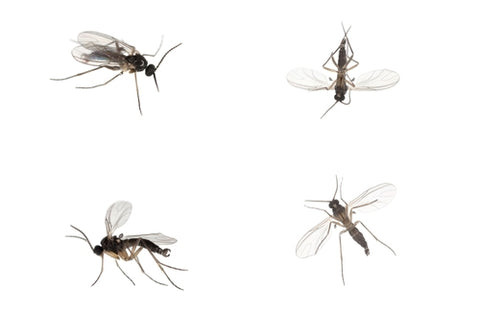 Gnats
Gnats
Gnats are generally black and slender with long legs and antennae. Typically, they do not exceed 3.3mm in length. These pests thrive in damp environments.
How do gnats get into your house?
Gnats can enter your home through the smallest openings, such as cracks in walls and foundations, as well as through doors and windows. They exploit any available entry point.
Where do gnats live in your home?
Gnats thrive in damp, dark places with decomposing organic matter, such as trash cans, sinks, drains, toilets, and around decaying fruit. They are drawn to moisture and decay.
When are gnats most active?
Gnats are most active at dusk and dawn. They flourish during wet seasons like spring and winter, finding ideal breeding conditions.
Other characteristics of gnats:
Some gnat species, like fungus gnats, bite. Others can also bite and potentially carry infectious diseases, making them a health concern.
1.2. Fruit Flies
What do fruit flies look like?
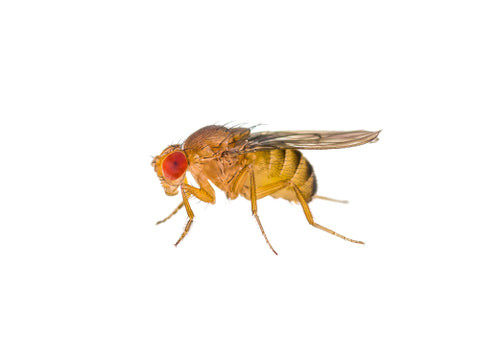 Fruit flies
Fruit flies
Fruit flies are closely related to gnats but belong to a different insect order. They are typically tan to black, oval-shaped, and approximately 3-4mm long. Many fruit flies have distinctive red eyes.
How do fruit flies get into your home?
Fruit flies are commonly brought into homes on fruits. They are frequently carried indoors on the surface of fruits and vegetables.
Where do fruit flies live in your home?
Fruit flies are commonly found near fruit left on counters, especially overripe or rotting fruit. They feed on the yeast and sugars produced by these fruits and lay their eggs on the fruit skins. They also favor drains clogged with food debris and fermenting sugars from spilled alcohol.
When are fruit flies most active?
Fruit flies are most active on warm, sunny days and are prevalent during late summer and fall. They seek out ripe and fermenting substances.
Other characteristics of fruit flies:
Fruit flies are attracted to fruits such as apples, bananas, melons, squash, and tomatoes. They also target vegetables like potatoes and onions, as well as fungi like mushrooms.
1.3. Drain Flies
What do drain flies look like?
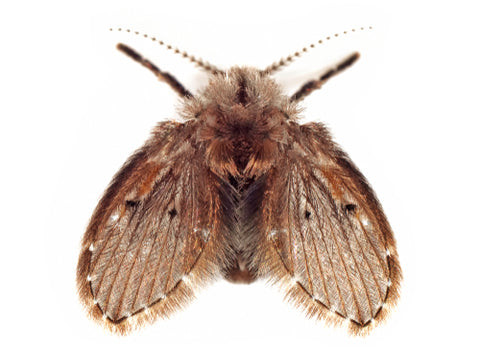 Drain flies
Drain flies
Drain flies, also known as sewage flies, filter flies, or moth flies, are light gray or tan and range from 1.5mm to 5mm in length. They have long antennae and bodies covered in small hairs, which can cause them to be mistaken for moths.
How do drain flies get into your home?
Unlike gnats and fruit flies, drain flies find their way into homes independently. They are attracted to drains with excess organic material and enter through windows, doors, or tiny holes. They typically do not enter through the drains themselves.
Where do drain flies live in your home?
Drain flies congregate in drains, particularly garbage disposals. They lay their eggs in the accumulated gunk lining clogged or greasy pipes and feed on sewage or decomposing organic matter.
When are drain flies most active?
Drain flies are most active at night, especially during the summer. They can survive in a warm home during the winter.
Other characteristics of drain flies:
Drain flies can fly, but they are not particularly skilled at it. Spotting them in flight usually indicates they are living and breeding nearby. For longer distances, they prefer to hop or walk.
1.4. Clothes Moths
What do clothes moths look like?
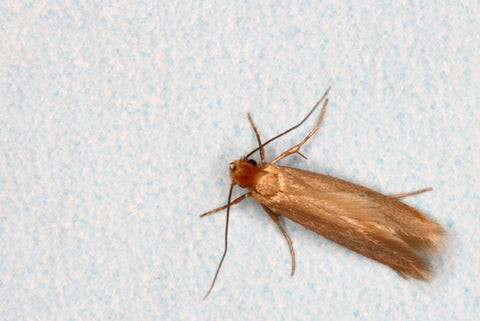 Webbing moth
Webbing moth
There are two main types of clothes-eating moths: casemaking clothes moths and webbing clothes moths. Casemaking clothes moths create a silken case to live in during their larval stage, while webbing moths do not use a case but leave significant webbing in areas where they have fed.
Adult casemaking moths are gray-brown with dark spots, whereas webbing moths are golden-yellow with a slight sheen. Both types are approximately 15mm (about half an inch) long.
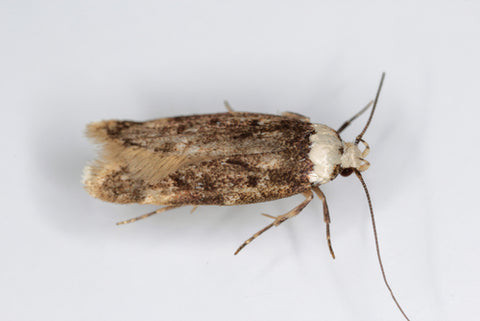 Casemaking clothes moths
Casemaking clothes moths
How do clothes moths get into your home?
Clothes moths often enter homes via items purchased at thrift stores, secondhand shops, consignment stores, or garage sales. They prefer to hide under shirt collars, cuffed sleeves, seams, and buttons.
Where do clothes moths live in your home?
Clothes moths are typically found in dark closets but will also infest carpets, upholstery, tapestries, stuffed animals, taxidermied animals, and craft materials like yarn.
When are clothes moths most active?
Clothes moths are most active at night. Outdoors, they thrive in the spring but can live year-round in warm homes.
Other characteristics of clothes moths:
The larvae, not the adult moths, consume clothing and carpets. Their preferred food is animal fibers such as cashmere, feathers, fur, felt, leather, silk, and wool.
2. How Can You Get Rid of Flying Bugs?
Eliminating flying bugs requires a multi-faceted approach. Immediate relief can be achieved by targeting hotspots, while long-term prevention involves identifying entry points and eliminating food sources and breeding grounds. Addressing these aspects will significantly reduce infestations. Let’s explore practical methods to rid your home of these persistent pests.
2.1. Target Hotspots for Some Immediate Relief
One of the first steps most people take is to address the immediate presence of flying insects. This approach offers quick relief, especially when you have limited time to address the problem thoroughly.
Using sprays designed to target these pests can be highly effective. For example, Wondercide’s Indoor Pest Control for Home + Kitchen Sprays utilize essential oils such as Lemongrass, Peppermint, Cedarwood, and Rosemary. According to Wondercide, these sprays are proven to kill moths, flies, gnats, and many other common household pests when used as directed.
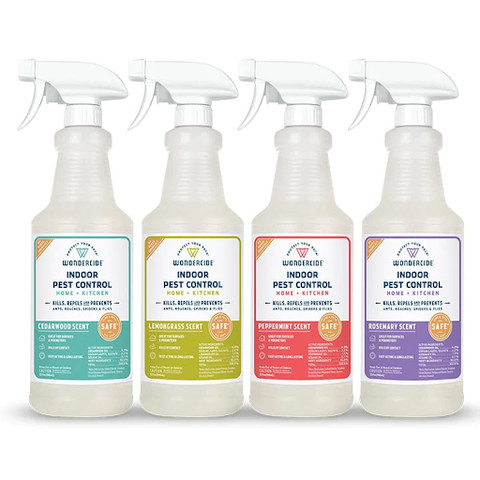 Indoor pest control spray
Indoor pest control spray
Indoor sprays can be applied on most surfaces throughout your home, although it’s best to avoid direct contact with plants. Always follow the instructions to ensure safe and effective application.
For fruit flies, traps can be particularly useful. The Wondercide Fruit Fly Trap is designed specifically to capture these pests effectively. According to Wondercide, the trap works optimally for up to 21 days.
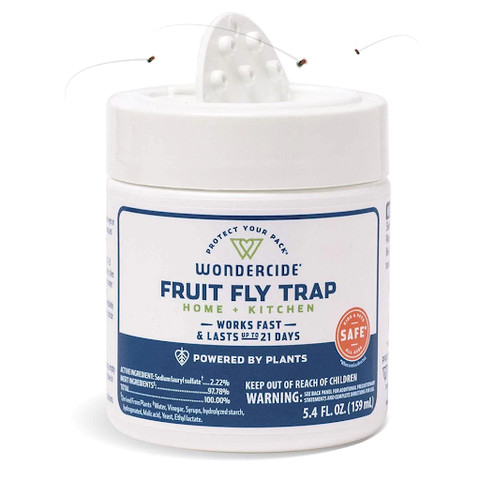 Fruit fly trap
Fruit fly trap
Beyond these specific products, Wondercide offers solutions for other flying insects, such as Ant and Roach spray and Wasp and Hornet spray for home and kitchen, as well as Mosquito and Fly spray for both indoor and outdoor use.
2.2. Identify How the Bugs Are Getting Into Your Home and Adjust Behavior When Possible
Maintaining a clean living space can help reduce bug infestations, but even meticulously clean homes can experience a sudden influx of flying insects. The question then becomes, “Why do I keep getting flying bugs in my house?”
Insects seek food, water, and shelter, and homes naturally offer these resources. Common entry points and attractants include:
-
Items Brought into the Home:
- Trash cans, recycling bins, and compost bins
- Pets, especially those that go indoors and outdoors
- Pet food, particularly birdseed
- Potted plants
-
Humid Areas or Places Where Water Collects:
- Basements
- Open garages
- Pipes
- Rain gutters
- Stacks of firewood
-
Areas of the House Needing Repair:
- Cracks in the foundation or siding
- Areas with water damage
- Window screens with holes
- Damaged roofs
Regularly inspecting these areas can help identify how bugs are entering your home. Leave the space undisturbed for an hour or two before looking to increase the chance of observing bug activity. Once identified, you can seal these areas or modify behaviors that attract pests. While completely eliminating bug entry points may not always be possible, these steps can significantly reduce their access.
2.3. Get Rid of Their Food Sources and Breeding Grounds
Once you’ve identified the type of pest and their living areas, the next step is to eliminate their food sources and breeding grounds, which are often the same.
To make your home less attractive to bugs, consider the following steps:
- Remove Produce Left Out on Counters: Decaying fruit and vegetables are a major attractant.
- Clean Dirty Dishes Promptly: Do not let dirty dishes pile up, especially overnight.
- Properly Seal Alcohol Bottles: Wipe down and seal any bottles of alcohol to prevent spills and fermentation.
- Clean Dirty Drains: Clear clogged, greasy, and dirty drains regularly.
- Seal Food Containers in the Pantry: Ensure that food containers are tightly sealed to prevent access by pests.
- Allow Soil to Dry Before Watering Plants: Let the top 2 inches of soil dry out before watering potted plants to avoid creating a damp breeding ground.
- Remove Infested Items: Remove any infested items such as clothing or food.
- Store Pet Food Properly: Store pet food in tightly sealed containers in a dry location.
- Take Out the Trash Regularly: Dispose of trash regularly and ensure that trash cans seal properly.
The specific food source and breeding ground will vary depending on the type of bug. For example, if you’re dealing with clothes moths, focusing on drains will not be as effective as targeting fabric items.
3. What Are the Key Strategies for Preventing Future Infestations of Tiny Flying Bugs?
Preventing future infestations involves a combination of proactive measures aimed at reducing attractants and entry points. By addressing both the internal and external factors that contribute to pest problems, homeowners can create a less hospitable environment for flying bugs. Let’s explore the essential strategies for long-term prevention.
3.1. Implement Regular Cleaning and Maintenance Practices
Regular cleaning is essential for preventing flying bug infestations. Focus on areas that tend to accumulate food debris and moisture, such as kitchens and bathrooms. Cleaning these areas regularly can eliminate potential food sources and breeding grounds.
- Kitchen: Wipe down counters, clean up spills immediately, and wash dishes promptly. Ensure that food storage containers are tightly sealed and that no food is left exposed.
- Bathrooms: Keep drains clean and clear of hair and other debris. Repair any leaks promptly to prevent moisture buildup, which can attract pests.
- General Home Maintenance: Regularly inspect and maintain your home’s structure to prevent entry points for pests. Seal cracks in the foundation, repair holes in window screens, and ensure that doors and windows are properly sealed.
3.2. Control Moisture Levels
Flying bugs are often attracted to moisture, making it important to control humidity levels in your home. Use dehumidifiers in damp areas such as basements and crawl spaces. Ensure proper ventilation in bathrooms and kitchens to prevent moisture buildup. Addressing moisture issues can significantly reduce the appeal of your home to pests.
3.3. Proper Food Storage
Proper food storage is crucial for preventing flying bug infestations. Store food in airtight containers to prevent pests from accessing it. Pay particular attention to grains, cereals, and pet food, as these are common attractants. By properly storing food, you eliminate a primary food source for many common household pests.
3.4. Maintain Your Yard and Garden
The exterior of your home can also play a role in attracting flying bugs. Keep your yard clean and well-maintained to reduce potential breeding sites.
- Remove Standing Water: Eliminate sources of standing water, such as bird baths, flower pots, and clogged gutters, as these can attract mosquitoes and other flying insects.
- Trim Vegetation: Keep vegetation trimmed and away from your home’s foundation to reduce hiding places for pests.
- Manage Compost and Trash: Keep compost piles and trash cans away from your home and ensure they are properly sealed.
3.5. Use Natural Repellents
Consider using natural repellents to deter flying bugs. Essential oils like peppermint, eucalyptus, and citronella have been shown to repel certain insects. Place cotton balls soaked in essential oils in areas prone to infestations or use a diffuser to spread the scent throughout your home.
According to a study published in the Journal of Economic Entomology, peppermint oil is effective at repelling mosquitoes. Additionally, eucalyptus oil has been shown to repel gnats and other small flying insects.
4. Understanding the Lifecycle and Habits of Common Flying Bugs
To effectively combat flying bugs, understanding their lifecycle and habits is crucial. Each type of pest has unique behaviors and breeding patterns that influence how you should approach their elimination. By knowing these details, you can target your efforts more effectively. Let’s delve into the lifecycle and habits of common flying bugs.
4.1. Gnats Lifecycle and Habits
Gnats have a relatively short lifecycle, which can range from a few days to several weeks, depending on the species and environmental conditions. The lifecycle consists of four stages: egg, larva, pupa, and adult.
- Egg: Female gnats lay their eggs in damp soil or decaying organic matter.
- Larva: The larvae feed on fungi, algae, and decaying organic matter.
- Pupa: The larvae then pupate, transforming into adult gnats.
- Adult: Adult gnats emerge and begin the cycle anew.
Gnats are attracted to moisture and decaying organic matter, making them common in overwatered houseplants, compost bins, and drains. They are most active during dusk and dawn and thrive in wet seasons.
4.2. Fruit Flies Lifecycle and Habits
Fruit flies have a rapid lifecycle, completing their development from egg to adult in about a week under optimal conditions. The lifecycle consists of four stages: egg, larva, pupa, and adult.
- Egg: Female fruit flies lay their eggs on the surface of fermenting fruits and vegetables.
- Larva: The larvae feed on the decaying fruit, growing rapidly.
- Pupa: The larvae then pupate, typically near the food source.
- Adult: Adult fruit flies emerge and continue the cycle.
Fruit flies are attracted to ripe and fermenting fruits and vegetables, as well as sugary substances. They are most active during warm, sunny days and are commonly found in kitchens and near fruit bowls.
4.3. Drain Flies Lifecycle and Habits
Drain flies have a lifecycle of about two to three weeks, depending on environmental conditions. The lifecycle consists of four stages: egg, larva, pupa, and adult.
- Egg: Female drain flies lay their eggs in the gelatinous film that lines drains and sewers.
- Larva: The larvae feed on organic matter in the drains.
- Pupa: The larvae then pupate in the drain.
- Adult: Adult drain flies emerge and continue the cycle.
Drain flies are attracted to drains with excess organic material and sewage. They are most active at night and are commonly found in bathrooms, kitchens, and basements.
4.4. Clothes Moths Lifecycle and Habits
Clothes moths have a lifecycle that can range from a few months to over a year, depending on the species and environmental conditions. The lifecycle consists of four stages: egg, larva, pupa, and adult.
- Egg: Female clothes moths lay their eggs on clothing, carpets, and other textiles.
- Larva: The larvae feed on animal fibers such as wool, silk, and fur.
- Pupa: The larvae then pupate in a silken case.
- Adult: Adult clothes moths emerge and continue the cycle.
Clothes moths are attracted to dark, undisturbed areas where they can feed on natural fibers. They are most active at night and are commonly found in closets, attics, and basements.
5. How Effective Are DIY Methods for Controlling Flying Bugs?
DIY methods can be a cost-effective way to manage flying bug infestations. Many homeowners find success with simple solutions using household items. However, the effectiveness of these methods can vary depending on the severity of the infestation and the specific type of bug. Let’s explore the effectiveness of common DIY methods for controlling flying bugs.
5.1. Apple Cider Vinegar Traps for Fruit Flies
Apple cider vinegar traps are a popular and effective DIY method for controlling fruit flies. The sweet, fermented scent of apple cider vinegar attracts fruit flies, luring them into the trap.
How to Make an Apple Cider Vinegar Trap:
- Pour a small amount of apple cider vinegar into a jar or bowl.
- Add a drop of dish soap to break the surface tension of the vinegar.
- Cover the top of the jar with plastic wrap and secure it with a rubber band.
- Poke small holes in the plastic wrap.
- Place the trap near areas where fruit flies are prevalent.
The fruit flies will enter the trap through the holes but will be unable to escape, eventually drowning in the vinegar.
5.2. Drain Cleaning Solutions for Drain Flies
DIY drain cleaning solutions can help eliminate drain flies by removing the organic matter they feed on.
DIY Drain Cleaning Solution:
- Pour boiling water down the drain to loosen debris.
- Follow with a mixture of baking soda and vinegar (1/2 cup of baking soda followed by 1 cup of vinegar).
- Let the mixture fizz for 30 minutes.
- Flush the drain with hot water.
Repeating this process regularly can help keep drains clean and free of drain flies.
5.3. Essential Oil Sprays for Gnats
Essential oil sprays can be used to repel gnats and other small flying insects.
DIY Essential Oil Spray:
- Mix a few drops of essential oil (such as peppermint, eucalyptus, or citronella) with water in a spray bottle.
- Shake well to combine.
- Spray the mixture around areas where gnats are prevalent, such as near houseplants or in damp areas.
5.4. Pheromone Traps for Clothes Moths
Pheromone traps can be used to attract and trap adult clothes moths, preventing them from reproducing.
How Pheromone Traps Work:
- Pheromone traps contain a synthetic pheromone that mimics the scent of female clothes moths.
- Male clothes moths are attracted to the pheromone and fly into the trap.
- The moths become trapped on a sticky surface and die.
While pheromone traps are effective at trapping adult moths, they do not kill larvae.
5.5. Limitations of DIY Methods
While DIY methods can be effective for controlling small infestations, they may not be sufficient for larger or more persistent problems. DIY methods often address the symptoms of an infestation without addressing the underlying causes. In such cases, professional pest control services may be necessary.
6. How Often Should You Clean to Prevent Flying Bugs?
Maintaining a clean environment is a cornerstone of preventing flying bug infestations. However, the frequency of cleaning can vary depending on the specific conditions of your home and the type of pests you are dealing with. Let’s explore the recommended cleaning schedules for preventing flying bugs.
6.1. Daily Cleaning Tasks
Certain cleaning tasks should be performed daily to prevent flying bugs.
- Wipe Down Kitchen Counters: Wipe down kitchen counters after each meal to remove food spills and crumbs that can attract fruit flies and gnats.
- Wash Dishes: Wash dishes promptly after meals to prevent food buildup that can attract pests.
- Take Out the Trash: Take out the trash daily to prevent the accumulation of food waste that can attract flies and other insects.
6.2. Weekly Cleaning Tasks
Other cleaning tasks should be performed weekly to maintain a pest-free environment.
- Clean Drains: Clean drains weekly to prevent the buildup of organic matter that can attract drain flies. Use a drain cleaner or a mixture of baking soda and vinegar.
- Mop Floors: Mop floors to remove food spills and crumbs that can attract pests.
- Clean Bathrooms: Clean bathrooms weekly to prevent moisture buildup and remove soap scum and hair that can attract pests.
6.3. Monthly Cleaning Tasks
Certain cleaning tasks should be performed monthly to address less frequent but important pest prevention measures.
- Clean Pantry: Clean out the pantry monthly to remove expired food items and spills that can attract pests.
- Vacuum Carpets and Rugs: Vacuum carpets and rugs monthly to remove dust, dirt, and food particles that can attract clothes moths and other pests.
- Wash Curtains and Linens: Wash curtains and linens monthly to remove dust and allergens that can attract pests.
6.4. Seasonal Cleaning Tasks
Seasonal cleaning tasks can help address pest prevention measures that are more relevant during certain times of the year.
- Spring Cleaning: Perform a thorough spring cleaning to remove accumulated dirt and debris that can attract pests.
- Fall Cleaning: Prepare your home for winter by sealing cracks and crevices to prevent pests from entering.
- Yard Maintenance: Maintain your yard by removing leaf litter, trimming vegetation, and eliminating standing water to reduce pest breeding sites.
7. How to Choose the Right Pest Control Products for Flying Bugs
Selecting the right pest control products is essential for effectively managing flying bug infestations. With a variety of options available, it’s important to consider factors such as the type of pest, the severity of the infestation, and the safety of your family and pets. Let’s explore how to choose the right pest control products for flying bugs.
7.1. Identify the Type of Pest
The first step in choosing the right pest control product is to identify the type of pest you are dealing with. Different products are designed to target specific pests, so it’s important to choose a product that is effective against the type of flying bug in your home.
7.2. Consider the Severity of the Infestation
The severity of the infestation will influence the type of product you choose. For small infestations, DIY methods or over-the-counter products may be sufficient. For larger or more persistent infestations, professional pest control services may be necessary.
7.3. Choose the Right Type of Product
Various types of pest control products are available, each with its own advantages and disadvantages.
- Sprays: Sprays are effective for targeting specific pests and can be used to treat cracks, crevices, and other areas where pests are likely to hide.
- Traps: Traps are useful for capturing pests and can be used to monitor the severity of an infestation.
- Baits: Baits are effective for attracting pests and delivering a lethal dose of insecticide.
- Insect Growth Regulators (IGRs): IGRs disrupt the development of pests, preventing them from reproducing.
- Dusts: Dusts are useful for treating cracks and crevices and can provide long-lasting control.
7.4. Consider Safety
When choosing pest control products, it’s important to consider the safety of your family and pets. Look for products that are labeled as safe for use around children and pets and follow all instructions carefully.
7.5. Read Product Labels Carefully
Always read product labels carefully before using any pest control product. Pay attention to instructions, precautions, and first aid information.
7.6. Consider Professional Pest Control Services
For severe or persistent infestations, consider hiring a professional pest control service. Professional pest control technicians have the knowledge, experience, and equipment to effectively manage pest infestations and can provide long-term solutions.
8. What Are the Potential Health Risks Associated With Flying Bug Infestations?
Flying bug infestations can pose several health risks, depending on the type of pest and the severity of the infestation. Certain insects can transmit diseases, trigger allergies, or cause other health problems. Let’s explore the potential health risks associated with flying bug infestations.
8.1. Disease Transmission
Some flying bugs, such as mosquitoes and flies, can transmit diseases to humans and animals. Mosquitoes can transmit diseases such as malaria, Zika virus, and West Nile virus. Flies can transmit diseases such as dysentery, typhoid fever, and cholera.
According to the Centers for Disease Control and Prevention (CDC), mosquitoes are responsible for transmitting some of the most deadly diseases in the world.
8.2. Allergic Reactions
Some flying bugs, such as gnats and moths, can trigger allergic reactions in sensitive individuals. Allergic reactions can range from mild skin irritation to severe respiratory problems.
8.3. Bites and Stings
Some flying bugs, such as mosquitoes and wasps, bite or sting humans and animals. Bites and stings can cause pain, swelling, itching, and allergic reactions.
8.4. Contamination of Food and Surfaces
Flying bugs can contaminate food and surfaces with bacteria, viruses, and other pathogens. Contamination can lead to food poisoning and other illnesses.
8.5. Psychological Distress
Flying bug infestations can cause psychological distress, anxiety, and fear. The constant presence of pests can be stressful and disruptive to daily life.
9. How to Seal Entry Points to Prevent Flying Bugs From Entering Your Home
Sealing entry points is a crucial step in preventing flying bugs from entering your home. By identifying and sealing potential access points, you can create a barrier that keeps pests out. Let’s explore how to seal entry points to prevent flying bugs.
9.1. Inspect Your Home
The first step in sealing entry points is to thoroughly inspect your home for potential access points. Pay attention to areas such as cracks in the foundation, gaps around windows and doors, and holes in window screens.
9.2. Seal Cracks in the Foundation
Cracks in the foundation can provide easy access for flying bugs. Seal cracks with caulk or concrete sealant.
9.3. Caulk Gaps Around Windows and Doors
Gaps around windows and doors can allow flying bugs to enter your home. Caulk gaps with weather-resistant caulk.
9.4. Repair or Replace Damaged Window Screens
Holes in window screens can provide easy access for flying bugs. Repair or replace damaged window screens to prevent pests from entering.
9.5. Seal Openings Around Pipes and Wires
Openings around pipes and wires can provide access for flying bugs. Seal openings with caulk or expanding foam sealant.
9.6. Install Door Sweeps
Install door sweeps on exterior doors to prevent flying bugs from entering under the door.
9.7. Cover Vents and Chimneys
Cover vents and chimneys with screens to prevent flying bugs from entering.
10. What Are Some Common Misconceptions About Flying Bugs?
There are several common misconceptions about flying bugs that can lead to ineffective pest control strategies. Understanding these misconceptions can help you approach pest management more effectively. Let’s debunk some common myths about flying bugs.
10.1. Myth: Flying Bugs Are Only a Problem in Dirty Homes
Reality: While cleanliness can help prevent infestations, flying bugs can infest even the cleanest homes. Pests are attracted to food, water, and shelter, which can be found in any home.
10.2. Myth: All Flying Bugs Bite
Reality: Not all flying bugs bite. Some, like fruit flies and drain flies, do not bite humans. Others, like mosquitoes and gnats, do bite and can transmit diseases.
10.3. Myth: Flying Bugs Only Live for a Day
Reality: The lifespan of flying bugs varies depending on the species. Some, like fruit flies, can live for several weeks. Others, like clothes moths, can live for several months.
10.4. Myth: You Can Get Rid of Flying Bugs by Simply Swatting Them
Reality: Swatting flying bugs may provide temporary relief, but it does not address the underlying causes of the infestation. To effectively control flying bugs, you need to eliminate their food sources, breeding grounds, and entry points.
10.5. Myth: Natural Pest Control Methods Are Not Effective
Reality: Natural pest control methods, such as essential oil sprays and apple cider vinegar traps, can be effective for controlling small infestations. However, for larger or more persistent problems, professional pest control services may be necessary.
Conclusion
Dealing with tiny flying bugs in your house can be frustrating, but with the right knowledge and strategies, you can effectively eliminate them and prevent future infestations. Remember to identify the type of bug you’re dealing with, target hotspots for immediate relief, and eliminate food sources and breeding grounds. By implementing regular cleaning practices, controlling moisture levels, and sealing entry points, you can create a pest-free environment in your home.
For more detailed information, resources, and solutions tailored to your specific needs, visit flyermedia.net. Discover expert advice, product recommendations, and the latest news in pest control to help you maintain a healthy and bug-free home. Explore flyermedia.net today and take the first step towards a pest-free living space.